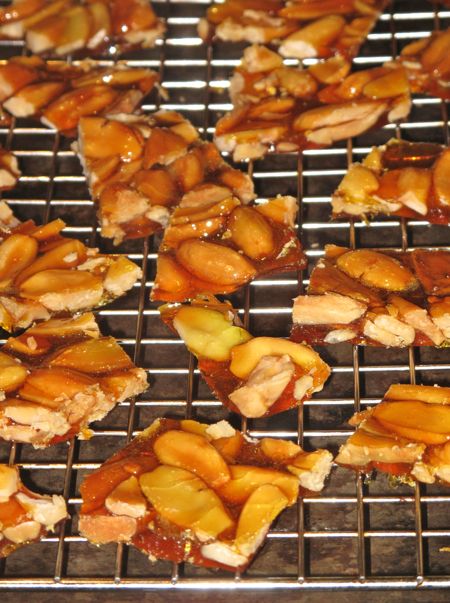Pili Nuts – Only in the Philippines
Posted By philippine evolution staff on February 5, 2012

philippine-evolution.com
PILI NUTS
Native to the Philippines, the pili nut is abundant and grows wild in many southern provinces, including Luzon, Mindanao and Visayas.
Pili Nut Fruit with Skin
Photo from: marketmanila.com
When raw, the pili nut is said by many to resemble the flavor of roasted pumpkin or pepita seeds, and when roasted, the pili nut’s mild, nutty flavor and tender-crispy texture is superior to that of the common almond. A perfect example would be a cross between a macadamia nut and a marcona almond.
Pili Nut in Shells
Photo from: 88db.com
Besides from being eaten raw or roasted, pili nuts are also used in chocolate, ice cream, candies and baked goods as well.
Pili Nut Out of the Shell
Photo from: marketmanila.com
The largest buyers of pili nuts outside of the Philippines are in Hong Kong and Taiwan. There the pili nut is one of the major ingredients in a famous Chinese dessert known as “moon cake“.
Shelled Pili Nuts
Photo from: sulit.com.ph
Aside from being a treat for your taste buds, the pili nut is also a nutritional treat for your body. Nutritionally, the pili nut is high in calcium, phosphorus, and potassium, and rich in fats and protein.
Crispy Pili Nut
Photo from: food.theplainjane.com
Pili nuts are also rich in oil. They yield a light yellow oil consisting mainly of oleic glycerides and palmitic acids (60:40 percent respectively), very similar to olive oil.
Salted Pili Nut
Photo from: tanglednoodle.blogspot.com
Unfortunately, unless you live in the Philippines, pili nuts can be extremely hard to find. With the extremely hard shell encasing the pili nut, most commercial plantations do not see the value of the nut. Therefore, most of the pili nut trees grow wild rather than in plantations, making the harvesting of the nut erratic and limited.
Pili Nuts Dipped in Caramelized Sugar
Photo from: asiafinest.com
As new breeds are being introduced with easier to access fruit and new devices are invented for the opening of the pili nut, the future of the pili nut definitely looks bright.
One downside: that wonderful, bountiful, nutritional oil that makes up the pili nut also causes it to spoil rather quickly. Any nuts found outside of the Philippines would more than likely already be preserved with salt or sugar.
Pili Nut Brittle
Photo from: marketmanila.com
Text Above From: zimbio.com
INVESTMENT OPPORTUNITY
Pili Nut Tree
Photo from: nowpublic.com
Investing in Philippine pili nut trees might be an overlooked opportunity due to the lack of media exposure.
Philippines – February 1, 2010 – “One of the best Philippines investments might be the organic farms growing pili nuts; pili trees can give a harvest for up to 100 years” according to Will Irwin who is currently writing his next book ‘Additional Income for Expats in the Philippines’. It is viewed as a good alternative to the usually offered real estate investments like condotels and apartments. Projected ROI is expected to be higher also; pili nuts are one of the highest profit products exported from the Philippines.
Pili Nut Delicacies
Photo from: marketmanila.com
The basic idea boils down to the fact that the Philippines has all that is required to produce extremely high yields in agriculture; what is lacking is mostly the implementation of the latest know-how and technologies. Agro-business in general has created one of the richest people in this country.
Pili Nut Pastry Business
Photo from: itdibiz.com
A group of ‘non-Filipinos’ have made a start with a 40 hectare organic pili nut farm. Technical know-how is provided by foreign experts, researchers from Philippine Universities and representatives of the Department of Agriculture, Trade and Industry etc.
Pili Nut Tart
 Photo from: melovescooking.blogspot.com
Photo from: melovescooking.blogspot.com
They are looking for investors to expand their business and ultimately anyone would be allowed to invest in one hectare or more of the ‘farm’. This means that not only the ‘bigger players’ can make a profit but really any expat or retiree; this provides for a nice monthly supplemental income.
Chocolate Covered Pili Nuts
Photo from: shootfirsteatlater.com
The projects have full support of the Philippine Government because it’s ‘Green/Eco’ and brings development to rural areas; Eco-tourism included.
Pili nut trees (Canarium ovatum Engl.) are one of the most typhoon-resistant species and grow in tropical Asia and the Pacific. In the Philippines only the Bicol Region is known to provide a suitable soil and climate. Investors are aiming for the island Tablas (Romblon) because it is much less typhoon-effected. Pili nuts are mainly an export product.
Retirement Villages for Americans, Europeans and other nationals are already being build near the projected farms; the whole location is developing very fast meaning great appreciation of real estate prices (whether residential of agricultural land); also due to increasing (Eco-) tourism.
Local Filipino farmers are not negatively affected because most products are for export plus they benefit from the fact that the retirement villages and organic farms create jobs and provide non-profit support for them also.
Will Irwin is the author of several books about ‘Living in the Philippines’ for expats and retirees and is an appointed consultant for the ‘Organic Pili Nuts Farm Investment’ project. He can be contacted at http://www.sibonga.com/contact_us.htm.
Text Above From: agribusinessweek.com
RECOMMENDED READINGS
 Philippines Investment & Business Opportunities Yearbook (World Investment & Business Opportunities Library) – Philippines Investment & Business Opportunities Yearbook (World Investment & Business Opportunities Library) GET YOUR COPY
Philippines Investment & Business Opportunities Yearbook (World Investment & Business Opportunities Library) – Philippines Investment & Business Opportunities Yearbook (World Investment & Business Opportunities Library) GET YOUR COPY
 Doing Business And Investing in Philippines Guide (World Business, Investment and Government Library) – Strategic and practical information for conducting business and investing in the country. Business opportunities, regulations, contacts and more. GET YOUR COPY
Doing Business And Investing in Philippines Guide (World Business, Investment and Government Library) – Strategic and practical information for conducting business and investing in the country. Business opportunities, regulations, contacts and more. GET YOUR COPY
 Business Guide to the Philippines (Business Guide to Asia S.) – The Business Guide to the Philippines, part of the Business Guide to Asia Series, provides detailed information on setting up and running business ventures in the Philippines.
Business Guide to the Philippines (Business Guide to Asia S.) – The Business Guide to the Philippines, part of the Business Guide to Asia Series, provides detailed information on setting up and running business ventures in the Philippines.
All contributors are experts and specialists in their fields, providing you with an unparalleled wealth of insider knowledge. Each chapter is packed with the kind of information and advice usually available only to elite clients with large budgets for outside consultants. GET YOUR COPY













Comments